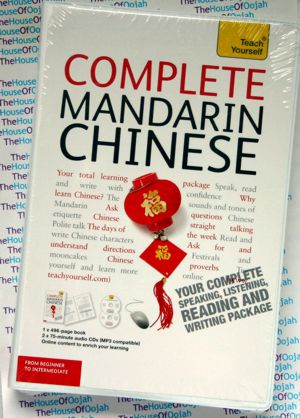Teach Yourself Complete Mandarin Chinese - 2 Audio CDs and Book

Teach Yourself Complete Mandarin ChineseBook and 2 Audio CDsGet Other Chinese - Mandarin and Cantonese language learning Audio click here |
 |
Teach Yourself Complete Mandarin Chinese - Book and 2 Audio CDs Brand New : . 496 page Book and 2 CDs Are you looking for a complete course in Mandarin Chinese which takes you effortlessly from beginner to confident speaker? Whether you are starting from scratch, or are just out of practice, Complete Mandarin Chinese will guarantee success! Now fully updated to make your language learning experience fun and interactive. You can still rely on the benefits of a top language teacher and our years of teaching experience, but now with added learning features within the course and online. The course is structured in thematic units and the emphasis is placed on communication, so that you effortlessly progress from introducing yourself and dealing with everyday situations, to using the phone and talking about work. By the end of this course, you will be at Level B2 of the Common European Framework for Languages: Can interact with a degree of fluency and spontaneity that makes regular interaction with native speakers quite possible without strain for either party. Learn effortlessly with a new easy-to-read page design and interactive features: NOT GOT MUCH TIME? AUTHOR INSIGHTS GRAMMAR TIPS USEFUL VOCABULARY DIALOGUES PRONUNCIATION TEST YOURSELF EXTEND YOUR KNOWLEDGE TRY THIS * New updated edition of a well respected bestseller Script - the course teaches both pinyin and Chinese characters Table of Contents: About the Author:
About Mandarin Chinesetraditional Chinese is a category of related Chinese dialects spoken across most of northern and south-western China. When taken as a separate language, as is often done in academic literature, the Mandarin dialects have more speakers than any other language. In English, Mandarin can refer to either of two distinct concepts: * to Standard Chinese or Standard Mandarin (Putonghua/Guoyu/Huayu/Hanyu), which is based on the particular Mandarin dialect spoken in Beijing. Standard Mandarin functions as the official spoken language of the People's Republic of China, the official language of the Republic of China (Taiwan), and one of the four official languages of Singapore. ‘Chinese’ — in practice Standard Mandarin — is one of the six official languages of the United Nations. In everyday use, Mandarin refers usually to just Standard Mandarin (Putonghua/Guoyu). In its broader sense, Mandarin is a diverse group of related dialects, some less mutually intelligible than others. It is a grouping defined and used mainly by linguists, and is not commonly used outside of academic circles as a self-description. Instead, when asked to describe the spoken form they are using, Chinese speaking a form of non-Standard Mandarin will describe the variant that they are speaking, for example Sichuan dialect or Northeast China dialect, and consider it distinct from ‘Standard Mandarin’ (putonghua); they may not recognize that it is in fact classified by linguists as a form of ‘Mandarin’ in a broader sense. Nor is there a common ‘Mandarin’ identity based on language; rather, there are strong regional identities centred on individual dialects, because of the wide geographical distribution and cultural diversity of its speakers. Moreover, it is of note that despite its wide use in the Occident, most native Mandarin speakers are reluctant to recognize the term 'Mandarin', since the word does not reflect any Chinese origin. Instead, they would rather call the language simply 'standard Chinese'. From an official point of view, there are two versions of Standard Mandarin, since the Beijing government refers to that on the Mainland as Putonghua, whereas the Taiwanese government refers to their official language as Kuo-yü (Guoyu in pinyin). Technically, both Putonghua and Guoyu base their phonology on the Beijing accent, though Putonghua also takes some elements from other sources. Comparison of dictionaries produced in the two areas will show that there are few substantial differences. However, both versions of ‘school’ Standard Mandarin are often quite different from the Mandarin dialects that are spoken in accordance with regional habits, and neither is wholly identical to the Beijing dialect. Putonghua and Guoyu also differ from the Beijing dialect in vocabulary, grammar, and usage. It is important to note that the terms ‘Putonghua (The Common Language)’ and ‘Guoyu’ refer to speech, and hence the difference in the use of simplified characters and traditional characters is not usually considered to be a difference between these two concepts. |
Teach Yourself Complete Mandarin Chinese - Book and 2 Audio CDs |

 0 Items (Empty)
0 Items (Empty)
